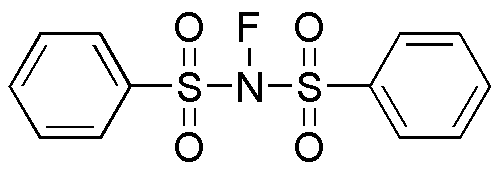N-Fluorobenzenesulfonimide is widely utilized in research focused on:
- Fluorination Reactions: This compound serves as a fluorinating agent in organic synthesis, allowing chemists to introduce fluorine into various organic molecules, which can enhance their reactivity and stability.
- Pharmaceutical Development: It plays a crucial role in the synthesis of fluorinated pharmaceuticals, which often exhibit improved biological activity and metabolic stability compared to their non-fluorinated counterparts.
- Material Science: N-Fluorobenzenesulfonimide is used in the development of advanced materials, including polymers and coatings, where fluorination can impart desirable properties such as chemical resistance and thermal stability.
- Catalysis: This chemical is employed in catalytic processes, particularly in the production of fine chemicals and agrochemicals, where its ability to facilitate reactions can lead to higher yields and reduced by-products.
- Environmental Applications: It is also being explored for use in environmental chemistry, particularly in the degradation of pollutants, where fluorination can enhance the breakdown of harmful substances.
General Information
Properties
Safety and Regulations
Applications
N-Fluorobenzenesulfonimide is widely utilized in research focused on:
- Fluorination Reactions: This compound serves as a fluorinating agent in organic synthesis, allowing chemists to introduce fluorine into various organic molecules, which can enhance their reactivity and stability.
- Pharmaceutical Development: It plays a crucial role in the synthesis of fluorinated pharmaceuticals, which often exhibit improved biological activity and metabolic stability compared to their non-fluorinated counterparts.
- Material Science: N-Fluorobenzenesulfonimide is used in the development of advanced materials, including polymers and coatings, where fluorination can impart desirable properties such as chemical resistance and thermal stability.
- Catalysis: This chemical is employed in catalytic processes, particularly in the production of fine chemicals and agrochemicals, where its ability to facilitate reactions can lead to higher yields and reduced by-products.
- Environmental Applications: It is also being explored for use in environmental chemistry, particularly in the degradation of pollutants, where fluorination can enhance the breakdown of harmful substances.
Documents
Safety Data Sheets (SDS)
The SDS provides comprehensive safety information on handling, storage, and disposal of the product.
Product Specification (PS)
The PS provides a comprehensive breakdown of the product’s properties, including chemical composition, physical state, purity, and storage requirements. It also details acceptable quality ranges and the product's intended applications.
Certificates of Analysis (COA)
Search for Certificates of Analysis (COA) by entering the products Lot Number. Lot and Batch Numbers can be found on a product’s label following the words ‘Lot’ or ‘Batch’.
*Catalog Number
*Lot Number
Certificates Of Origin (COO)
This COO confirms the country where the product was manufactured, and also details the materials and components used in it and whether it is derived from natural, synthetic, or other specific sources. This certificate may be required for customs, trade, and regulatory compliance.
*Catalog Number
*Lot Number
Safety Data Sheets (SDS)
The SDS provides comprehensive safety information on handling, storage, and disposal of the product.
DownloadProduct Specification (PS)
The PS provides a comprehensive breakdown of the product’s properties, including chemical composition, physical state, purity, and storage requirements. It also details acceptable quality ranges and the product's intended applications.
DownloadCertificates of Analysis (COA)
Search for Certificates of Analysis (COA) by entering the products Lot Number. Lot and Batch Numbers can be found on a product’s label following the words ‘Lot’ or ‘Batch’.
*Catalog Number
*Lot Number
Certificates Of Origin (COO)
This COO confirms the country where the product was manufactured, and also details the materials and components used in it and whether it is derived from natural, synthetic, or other specific sources. This certificate may be required for customs, trade, and regulatory compliance.

